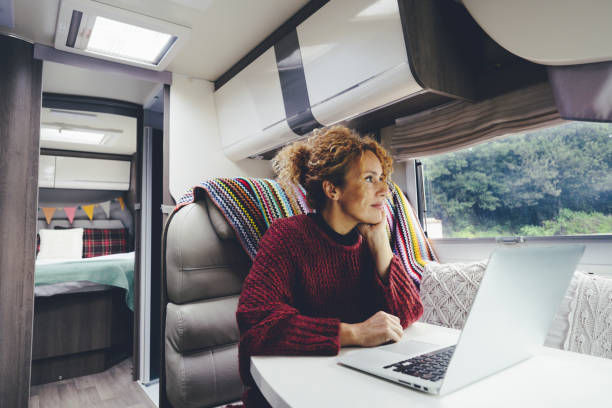- camphost7
- Sep 26
- 5 min read
A Deep Dive of Connectivity:
Internet While Full Time RV Living

One of the biggest questions full-time RVers ask is: “How do I stay connected?” Whether you’re working from the road, homeschooling kids, or just keeping up with Netflix and video calls with family, reliable internet is as important as air conditioning in July.
The truth? There’s no single perfect option but there are several that, when combined, can give you a strong, flexible setup.
Below is a deep dive into the most popular ways RVers stay online, complete with pros, cons, costs, reliability, and tips from the road.
1. Starlink (Satellite Internet)
Overview: Starlink has become a game-changer for full-time travelers. Using low-orbit satellites, it delivers broadband-level speeds almost anywhere with a clear view of the sky.
Average Speeds: 50–250 Mbps download, 10–25 Mbps upload
Latency: 20–50 ms (which means it's good for video calls and streaming)
Price: $150/month for RV plan + $599 for equipment
Reliability: High in rural/open areas; less reliable under heavy trees, deep valleys, or storms
Pros:
Works almost anywhere (great for remote campsites)
High enough speeds for streaming, Zoom calls, and even gaming
No contracts so you can pause the service when not traveling
Cons:
Expensive upfront and monthly
Requires a clear view of the sky (trees are your enemy)
Equipment is bulky compared to a hotspot
It works best out in the open. Park under heavy shade and your signal might sputter like wet firewood.
2. Cellular Hotspots (AT&T, Verizon, T-Mobile)
Overview: Hotspots use the same towers your cell phone does, but dedicated devices often get stronger, more reliable signals. Many RVers pair these with data-only SIM cards for better value.

Average Speeds: 10–100 Mbps (varies by location)
Latency: 20–60 ms
Price: $50–$100/month depending on carrier and plan
Reliability: Great near towns/highways, weaker in rural areas
Pros:
Easy to set up and portable
Cheaper than Starlink
Can connect multiple devices
Cons:
Signal depends on local tower coverage
Unlimited plans often have data caps or slowdowns after 50–100 GB
Outages more common in high-traffic areas
Big Tex Tip: Invest in a cell booster antenna. It can turn “one bar and praying” into “three bars and working.”
3. Mobile Router + Multiple SIM Cards
Overview: Serious digital nomads often use routers designed to hold SIM cards from different carriers. This lets them switch between Verizon, AT&T, or T-Mobile depending on coverage.
Average Speeds: 20–120 Mbps (depending on SIM and location)
Price: $300–$600 for equipment + $100–$200/month for multiple SIMs
Reliability: Excellent flexibility—always choose the best carrier for your area
Pros:
Reliable backup if one network fails
Stronger antennas than handheld hotspots
“Bonding” routers can combine multiple connections for even faster speeds
Cons:
Complicated to set up
Higher monthly costs
More equipment to store
Big Tex Tip: If you’re running a business from your rig, redundancy is worth it. Think of this like carrying both a spare tire and a patch kit you’ll thank yourself later for.
4. Campground Wi-Fi
Overview: Almost every RV park advertises free Wi-Fi, but seasoned campers know it’s usually spotty at best. Speeds tank once everyone logs on in the evening.

Average Speeds: 1–10 Mbps (varies wildly)
Price: Usually free, sometimes $10–$30/week for premium access
Reliability: Unreliable during peak times
Pros:
Free or cheap
No setup required
Great for checking emails or casual browsing
Cons:
Almost always too weak for video calls or streaming
Often unsecured so a privacy risk
Can’t rely on it as your main option
Big Tex Tip: Think of campground Wi-Fi like free campfire coffee, it’s nice if it’s hot and strong, but don’t count on it to get you through Monday morning meetings.
5. 5G Home Internet
Overview: Carriers like T-Mobile and Verizon now offer home internet via 5G. Some RVers use these routers on the road, though it’s not officially supported everywhere.
Average Speeds: 50–250 Mbps (in strong 5G areas)
Price: Around $50–$70/month
Reliability: Excellent in urban/suburban areas, limited in rural zones
Pros:
High speeds at a low cost
Unlimited data (in most cases)
Easy setup
Cons:
Service tied to specific locations; not always portable
Only works well in strong 5G coverage areas
May not be allowed to move device outside your registered service area
Big Tex Tip: This one’s like striking gold if your route takes you through good 5G coverage, enjoy the speeds while you can. But don’t rely on it in the middle of nowhere.
6. Public Wi-Fi (Libraries, Coffee Shops, Co-Working Spaces)
Overview: When all else fails, many RVers head into town and use public Wi-Fi. Not ideal for privacy or daily work, but handy in a pinch.

Average Speeds: 5–100 Mbps (depends on location)
Price: Free (just the price of a latte if you’re polite)
Reliability: Decent, but depends on the business
Pros:
Free or cheap
Usually faster than campground Wi-Fi
Breaks up cabin fever with a change of scenery
Cons:
Not private (use a VPN for security)
Can’t take calls easily in noisy spaces
Inconvenient if you’re out of town
Big Tex Tip: Coffee shops are a solid backup plan. Just don’t be the guy hogging a table for six hours on one cup of coffee. Buy the muffin too.
Cost & Reliability Ranking
Here’s a quick breakdown of these options, ranked by overall usefulness for full-time RVers who work from the road:
Starlink – Most reliable for remote work, but costly.
Cellular Hotspot + Booster – Best balance of cost and coverage.
Mobile Router w/ Multiple SIMs – Expensive, but unbeatable backup.
5G Home Internet – Great if your route overlaps with coverage zones.
Public Wi-Fi – Solid backup in towns.
Campground Wi-Fi – Okay for casual browsing, unreliable for work.
Final Thoughts

The key to stress-free remote work from your RV isn’t picking one option, it’s building a toolbox. Many full-time RVers carry both Starlink and a cellular hotspot, giving them flexibility whether they’re in the desert, the forest, or parked downtown.
Reliable internet on the road is less about chasing perfection and more about having backups. When you combine tools smartly, you can Zoom from the mountains, stream by the beach, and send that important email while parked under the Texas stars.
Big Tex Tip to Wrap It Up: Internet on the road is like weather in Texas.. Extremely unpredictable! Bring layers (of backup plans), and you’ll always be prepared.
Sources & further reading
(Selected for fact checks and plan details... Check these pages for the latest prices and plan specifics.)
Starlink Roam official page for Roam pricing and plan options. Starlink
Verizon mobile hotspot plans and device pages. Verizon
T-Mobile home/away info and 5G home plans. T-Mobile+1
Nomad Internet plans and RV pricing. Nomad Internet
Peplink / Pepwave reviews and mobile router notes for RVers. Mobile Internet Resource Center
Best 5G hotspot device roundup and hardware reviews. HighSpeedInternet.com
Reporting on major outages: Reuters and industry sources about Starlink and carrier outages. Reuters+1
